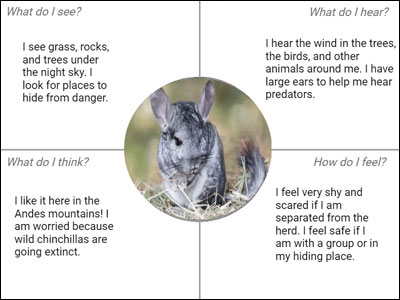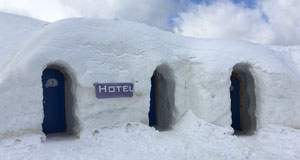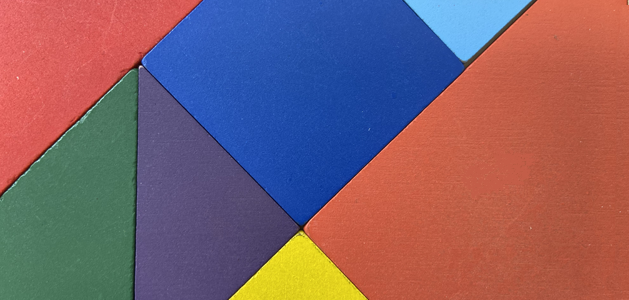Animal Diaries
Students write and design a diary for an animal to teach others about its unique physical characteristics and adaptations.

Task
Writers use personification to help a reader connect more effectively to the information and ideas they are explaining. In this project, students use personification to write a diary for an animal that teaches others about its unique physical characteristics, behaviors, and adaptations.
Engage
While students are often asked to write in a single style, such as narrative, information, or argument, “Skilled writers many times use a blend of these three text types to accomplish their purposes.”
Read a story to your students that shares an animal’s feelings and perspective about their world. For example, you might read Janell Cannon’s Crickwing or Verdi. Ask your students to share facts they learned about the animal’s physical characteristics, predators, diet, and habitat. In these stories, the authors combine narrative writing with information to tell a story that entertains and informs.
Let students know they will be combining narrative and informational writing to help a reader learn more about an animal.
Have students choose an animal to research. If you are studying a particular habitat or region or local flora and fauna, ask students to choose from a list you have created.
As students begin their research, guide their research with questions like:
- What does this animal look like?(physical characteristics/adaptations)
- What does this animal eat? (diet)
- What eats this animal? (predator)
- Where does this animal live? (habitat)
- When is this animal active? (behavior)
You can also encourage students to use graphic organizers, like clusters or webs, to organize the information they find. Because graphic organizers hold smaller amounts of information, they can help students avoid simply copying and pasting information from a reference document into a project.
Create a Graphic Organizer
Need a thought web, timeline, flowchart, or other graphic organizer for a lesson?
Create
Have students complete an empathy organizer such as this one from Wixie to help students begin thinking about facts from a first-person perspective.
Create
Once students have completed research on their animal, they need to begin writing entries for their animal diary. Choose how many entries you will ask them to write based on their academic and interest level as well as the classroom time you want to devote to this project.
While many students will likely be familiar with the idea of a diary, read and share different examples of diary entries with your students to provide exposure and set expectations. Create your own examples or read an entry or two from Doreen Cronin’s bug diary books. Many students will also be familiar with the Diary of a Wimpy Kid series by Jeff Kinney.
To help students better employ personification, focus their writing and language skills by asking them to consider:
- How do you feel about your looks?
- What are you afraid of?
- Who are your friends? What are they like?
- How do you feel about what you eat?
- How do you feel about where you live?
Give students time to think about how they might share feelings and events through a diary entry that also shares information they have learned about their animal. Have students share their ideas with another classmate or small group before they begin writing.
As students begin crafting their diary entries, remind them to use the first-person to narrate the events of the day from the perspective of the animal and descriptive language to make the feelings and events come alive for the reader.
Have students create diary entries on paper or use a productivity tool like Wixie to combine text, images, and voice narration for a digital diary. If you have access to a web cam, students can even capture their image and turn themselves into the animal.
Share
Have students share their animal diaries with the rest of the class. If you have printed their work, place it in your classroom library or create a collection other students can enjoy in your school’s library or media center. If students have created digital diaries, embed them in your classroom web site and have students present them to their peers.
Invite a science teacher and their students to the animal diary presentations. If they are old enough, ask these students to help evaluate student work.
You may also be able to work with staff at a local nature center or preserve to provide a real-world audience for student efforts. Your students can present and share their work with staff and visitors in a formal setting. If students have created digital diaries, share links to student work through QR codes so that patrons can use their personal devices to gain additional perspectives on the animals that live in the park or preserve.
Assessment
Create a rubric or checklist to help guide student work during research, writing, and final diary publishing.
Review student research notes and animal empathy maps to help students clarify thinking and improve comprehension of the informational texts they are encountering. Listen in on student discussions and collect peer reviews of research and rough drafts to help you monitor student progress. Use of graphic organizers during this process can also support your formative assessment efforts.
The final diary entries serve as a performance task you can use to evaluate student understanding of physical characteristics, habitat, and adaptation. It can also help you evaluate a student’s skill in combining informative and narrative writing.
Resources
Nicola Davies. Extreme Animals: The Toughest Creatures on Earth. ISBN: 0763641278
Pamela Hickman. Animals in Motion: How Animals Swim, Jump, Slither and Glide. ISBN: 1550745751
Standards
Next Generation Science Standards - Life Science Grades 3-5
3-LS2-1 Ecosystems: Interactions, Energy, and Dynamics
Construct an argument that some animals form groups that help members survive.
3-LS3-2 Heredity: Inheritance and Variation of Traits
Use evidence to support the explanation that traits can be influenced by the environment.
3-LS4-2 Biological Evolution: Unity and Diversity
Use evidence to construct an explanation for how the variations in characteristics among individuals of the same species may provide advantages in surviving, finding mates, and reproducing.
3-LS4-3 Biological Evolution: Unity and Diversity
Construct an argument with evidence that in a particular habitat some organisms can survive well, some survive less well, and some cannot survive at all.
4-LS1-1 From Molecules to Organisms: Structures and Processes
Construct an argument that plants and animals have internal and external structures that function to support survival, growth, behavior, and reproduction.
LS4.C: Adaptation
Develop a model to describe the movement of matter among plants, animals, decomposers, and the environment.
Common Core Anchor Standards for English Language Arts - Grade K-5
Reading Theme
Key Ideas and Details
1. Read closely to determine what the text says explicitly and to make logical inferences from it; cite specific textual evidence when writing or speaking to support conclusions drawn from the text.
Craft and Structure
Writing Theme
Text Type and Purpose
2. Write informative/explanatory texts to examine and convey complex ideas and information clearly and accurately through the effective selection, organization, and analysis of content.
Production and Distribution of Writing
4. Produce clear and coherent writing in which the development, organization, and style are appropriate to task, purpose, and audience.
Research to Build Present Knowledge
7. Conduct short as well as more sustained research projects based on focused questions, demonstrating understanding of the subject under investigation.
Speaking and Listening Theme
Comprehension and Collaboration
2. Integrate and evaluate information presented in diverse media and formats, including visually, quantitatively, and orally.
Presentation of Knowledge and Ideas
4. Present information, findings, and supporting evidence such that listeners can follow the line of reasoning and the organization, development, and style are appropriate to task, purpose, and audience.
ISTE NETS for Students 2016:
3. Knowledge Constructor
Students critically curate a variety of resources using digital tools to construct knowledge, produce creative artifacts and make meaningful learning experiences for themselves and others. Students:
a. plan and employ effective research strategies to locate information and other resources for their intellectual or creative pursuits.
b. evaluate the accuracy, perspective, credibility and relevance of information, media, data or other resources.
c. curate information from digital resources using a variety of tools and methods to create collections of artifacts that demonstrate meaningful connections or conclusions.
d. build knowledge by actively exploring real-world issues and problems, developing ideas and theories and pursuing answers and solutions.
6. Creative Communicator
Students communicate clearly and express themselves creatively for a variety of purposes using the platforms, tools, styles, formats and digital media appropriate to their goals. Students:
a. choose the appropriate platforms and tools for meeting the desired objectives of their creation or communication.
b. create original works or responsibly repurpose or remix digital resources into new creations.
c. communicate complex ideas clearly and effectively by creating or using a variety of digital objects such as visualizations, models or simulations.
d. publish or present content that customizes the message and medium for their intended audiences.













